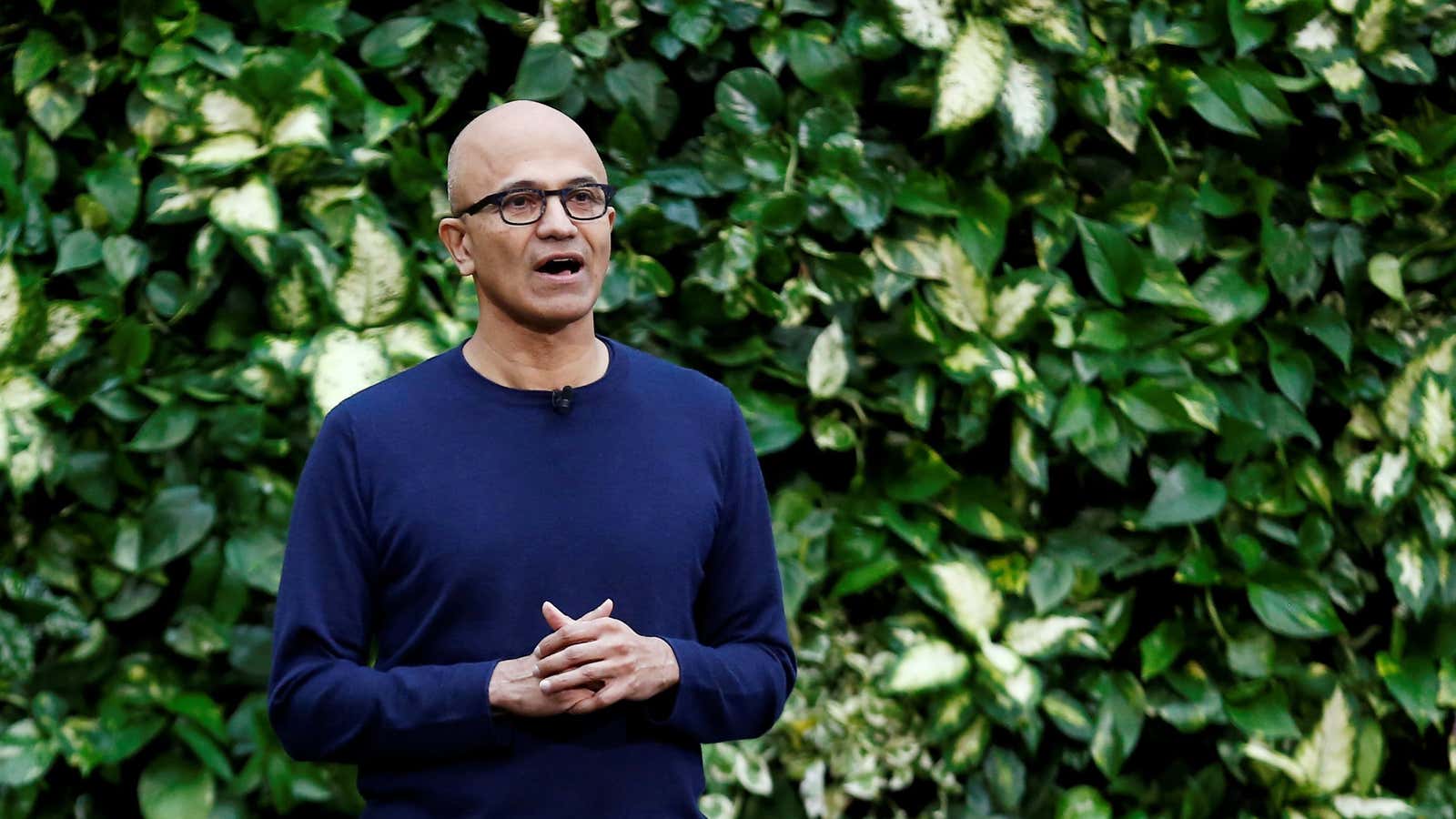“We don’t yet know which predictions about the climate will be most accurate, nor what effects we have failed to consider. But there is no denying the direction we are heading. Every government, company, and shareholder must confront climate change.”—BlackRock CEO Larry Fink
”No one company can solve this macro challenge alone, but as a global technology company we have a particular responsibility to do our part. That’s why today, we’re announcing an ambitious new plan to help address the sustainability of our planet. Today we’re making the commitment that by 2030, Microsoft will be carbon negative.”—Microsoft CEO Satya Nadella
It’s been a big January for pronouncements to address climate change—and for better sightlines into what we might come to expect from global business giants motivated to take action.
Larry Fink made a splash last week with his annual letter to CEOs of BlackRock’s portfolio companies. The key message was the need for significant action on climate; he titled the letter A Fundamental Reshaping of Finance. And if you want a taste of what the future looks like, head to the left coast—or read carefully, and then read again, Microsoft’s 30-year plan to become carbon negative.
Fink’s public stature and BlackRock’s weight as an investor in public equities rightfully call the attention of the business media. Fink stays on message, reminding his readers that the purpose of the enterprise is central to real value creation. This year he responded to critics who have been leaning on the world’s largest investor, committing to a more active stance on proxy voting on climate-related concerns, calling for better disclosure, and even promising to divest BlackRock’s mutual funds from coal.
But as virtually every business journalist has called out, Blackrock’s ability to influence the game is limited by its own business model—mainly the management of index funds, which buy and sell only to rebalance the holdings, never to exit. BlackRock may offer a new suite of options for investors that place money in the company’s mutual funds, but for a vast majority of their clients, the influence of BlackRock as their asset manager is indirect, more coach than quarterback.
Microsoft, on the other hand has just painted a picture in brilliant technicolor of what direct action on climate and carbon reduction look like. Microsoft continues to set the bar high—on purposeful leadership, on building a resilient and innovative culture, and now, on addressing what Fink just called a “structural, long-term crisis.”
Step one for Nadella and his team is a commitment to be “carbon negative” by 2030, reducing emissions by half and enlisting its entire supply chain, including “Scope 3” emissions—capturing the impact from the use of products, and all inputs to the product, not just the direct footprint of the company’s own operations.
Step two includes deploying Microsoft technology to help customers and suppliers reduce their own footprint, plus a $1 billion fund to “accelerate the global development of carbon reduction, capture, and removal technologies.”
And to finish things off, “by 2050 Microsoft will remove from the environment all the carbon the company has emitted either directly or by electrical consumption since it was founded in 1975.”
Microsoft CEO Satya Nadella has led a remarkable turnaround of the company. This next chapter moves well beyond the status quo and will cement Microsoft’s reputation as not only purposeful, but visionary.
The Seattle-based company is using its leverage as a market leader in technology, but also what it has learned about the power of pricing to change behavior. Microsoft was the first company to embed internal pricing to reward carbon reductions across its businesses. It will carry these lessons deep into its supply chain and into our collective future.
The impact of Microsoft’s plan will reverberate loudly as the breadth and depth of the company’s efforts sink in. Wisely, the company has also called out the need for public policy and committed to use its influence to support “new public policy initiatives to accelerate carbon reduction and removal.”
Fink focuses on the role of investors, but he also talks about the need for supportive policy. And as a result of changing attitudes inside companies, we are starting to see the ground shift in Washington, where business leaders and their trade associations have begun to take climate seriously. In a departure from the norm of working against public policy on climate, the head of the US Chamber of Commerce, Tom Donohue, went as far to say earlier this month that on key legislative issues including climate change, along with infrastructure investment and immigration reform, “inaction is not an option. So, let’s flip the conventional wisdom that nothing gets done in an election year.”
Felix Salmon of Axios writes that it doesn’t really make sense for Microsoft to do what it has pledged to do, when its competitors have not yet followed: “The option to pollute is worth money” he writes, adding that “the only way to eradicate that competitive disadvantage is to ensure that all companies have to play by the same rules.”
Yet when the system itself is at risk, traditional rules of competition fall apart. Microsoft is moving from strength to strength, and co-creation—not just competition—is part of its gameplan. So is using its voice to level the playing field.
Will we now see government policy take shape, reinforced by markets—or will it be the other way around? Either way, it sounds like a winning formula. The first step requires a first mover, who demonstrates what good practice and good policy look like. After this past week, we have a better clue what the future can hold.
Judith Samuelson is executive director of the Aspen Institute’s Business & Society Program and author of the forthcoming book “The Six New Rules of Business: Creating Real Value in a Changing World” (January 2021). Find her on Twitter at @JudySamuelson or on email at [email protected].
